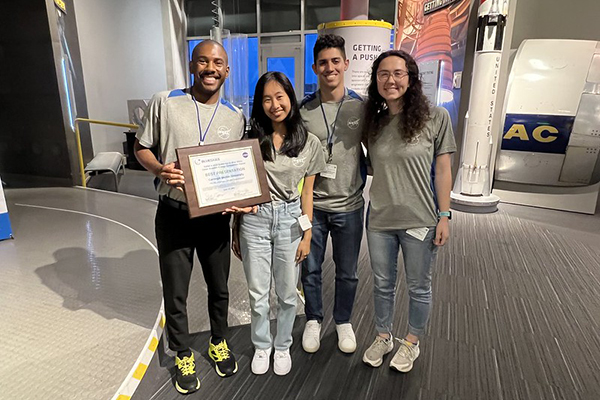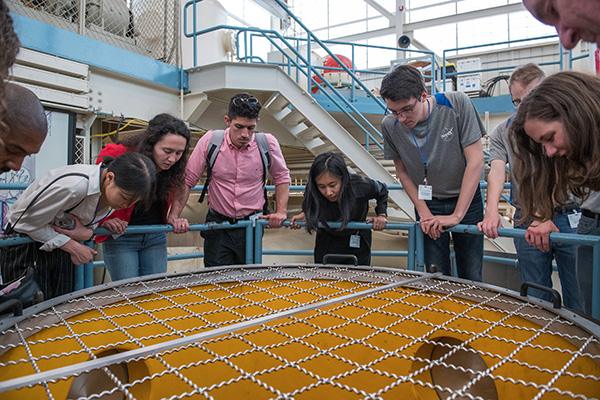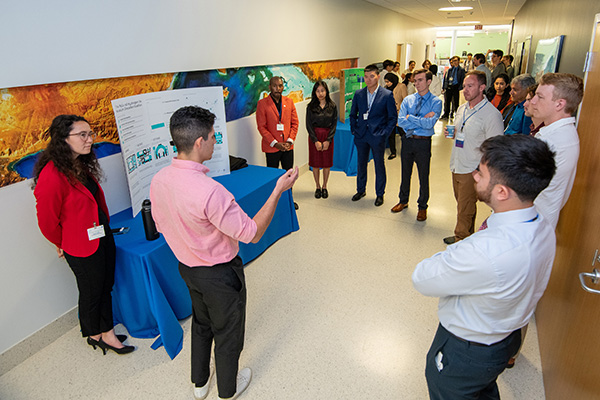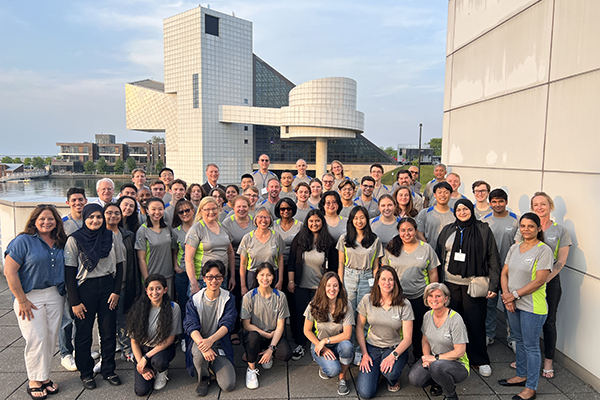CMU team wins Best Presentation Award at NASA competition
A group of Engineering and Public Policy graduate students took home the award for Best Presentation on behalf of the NASA’s Gateways to Blue Skies: Clean Aviation Energy Competition.
For a group of Carnegie Mellon University researchers, hydrogen is the future.
Engineering and Public Policy (EPP) graduate students Jon Gordon, Jaih Hunter-Hill, Anna Cobb, and Xiaohan Wu, and CMU Design student Dorthy Li presented their research, “The Role of Hydrogen in Aviation Decarbonization," at NASA's Gateways to Blue Skies: Clean Aviation Energy Competition, winning the Best Presentation award.
The competition, which is sponsored by NASA’s Aeronautics Research Mission Directorate’s University Innovation Project, “is an initiative to engage college students in researching climate-friendly technologies and applications that will establish a zero emissions future for aviation.”
The theme of this year’s contest asked students to conceptualize the life cycle of a clean energy option, from source to flight. Presentations were judged on feasibility, viability, and environmental impact.
Gordon said aviation is one of the hardest transportation sectors to decarbonize, but he feels there is real potential for hydrogen as a fuel source.
“We spent time looking into other alternative fuels that we thought could be interesting, but we ended up taking the approach that if we want our work to really mean something, we have to choose what we feel is the most realistic option,” Cobb said.
Moving forward, Gordon said their hope is that NASA, the Federal Aviation Administration, and the Department of Energy (DOE) will seriously consider their research and take specific action as a result.
“I hope our research for this NASA competition could provide valuable insights for decision-makers in the aviation industry,” Wu said. “Moreover, I also hope this research could bring a heated discussion on hydrogen's role in transportation decarbonization in the academic world.” The team summarized their work into a policy brief that they plan to share with the hydrogen and aviation community. Their infographic, and full report are available.
Gordon said the team feels that aviation is not discussed nearly enough in conversations about hydrogen end-users. He explains that the DOE is investing billions of dollars into Hydrogen Hubs––hydrogen production facilities that will be placed in eight to 10 areas across the country. He said if aviation is not part of the conversation as a hydrogen offtaker while these hubs are being created, it will delay hydrogen’s role in aviation decarbonization by years.
“If we act now, we can decarbonize aviation much more,” Gordon said. “How fast hydrogen is able to penetrate the market of aviation is dependent on the next few years of planning.”
Cobb explained the difficulties in decarbonizing aviation include the slow turnover rate for planes (30+ years), fueling infrastructure, and range.
“Being limited in range and fueling infrastructure introduces difficulties with flight scheduling; certain aircrafts can only fly to certain airports,” she said.
If we act now, we can decarbonize aviation much more.
Jon Gordon, Graduate Student, Engineering and Public Policy
Gordon said they anticipate three types of energy sources to replace jet fuel: batteries, hydrogen, and sustainable aviation fuel. Batteries will be used for short-range flights while hydrogen can be used for longer travel times. While airlines have the goal of having net-zero emissions by 2050, Gordon noted they can’t reach that goal by using sustainable aviation fuel because it still produces emissions, albeit less than traditional jet fuel.
“We think it’s extra important for hydrogen to be part of the solution because it can actually be zero emission,” he said.
The team took a four-pronged approach to their research that included a literature review of more than 70 sources, interviews with 13 stakeholders, market share analysis, and a multi-objective optimization model. The goal of the optimization model is to analyze trade-offs between their two objectives: minimizing emissions and minimizing costs.
Peter Zhang, assistant professor of operations research in the Heinz College and team advisor, said he was impressed by how independent and motivated the team was.
“The most impressive part is the amount of details and perspectives they bring into every meeting—a strong indicator of their enthusiasm and work ethic,” Zhang said. “In a good project like this, advisors have enough ‘ingredients’ to work with and can very quickly help them prioritize.”
The team also created and defined a supply chain system to illustrate how hydrogen will be transported from hubs to airports.
“With our optimization model, we're able to choose how we want to make hydrogen and, probably more importantly, how we want to move that hydrogen in terms of what's going to be the most cost effective versus emissions intensive,” Cobb said.
Hunter-Hill said one of the challenges in their research was coming up with realistic ways to achieve a future that does not yet exist.
“We had to come up with best-case assumptions for the world that could be. I think one of the challenges with that is so much of the analysis that we found is based upon very case- specific studies,” Hunter-Hill said. “We wanted to try to account for different outcomes in a world that we can't predict.”
Hunter-Hill said the creation of the supply chain process is one of the things that makes their research stand out.
“We’re trying to integrate multiple sources of information to create a future that doesn't exist but is realistic to potentially exist,” he said.
Doing research in a team environment, Wu said, was inspirational. He explained they were able to split up the work based on everyone's strengths, and he worked on assessing hydrogen’s environmental impact by building and solving the model.
“I think the biggest success was team cooperation,” Wu said. “Every team meeting was very productive and inspirational, and everyone got and gave a lot of useful ideas in those meetings we had. Every teammate cared about this project very much and devoted 100%.”




